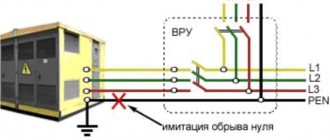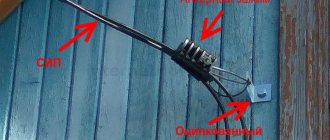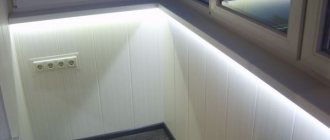01/25/201701/25/2017 master
The garage is not only a protected parking place for your “iron horse”, but also a place where you can do its repairs. Therefore, it is very important that the garage is well lit. But here certain difficulties may arise due to the frequent lack of wiring and banal electricity in such buildings. Such difficulties often arise when the garage building was built with your own hands and far from the power line.
Garage lighting
In such a situation, it will be relevant to make autonomous garage lighting. Our article today will tell you what you need to know to make such lighting yourself.
How is lighting done?
When constructing any premises, lighting systems should always be included at the planning stage. This is especially important for buildings such as a garage, which you can build with your own hands without any problems. Before installing autonomous lighting in this room, you need to consider the following points:
- what level of lighting needs to be organized;
- what lighting fixtures will be used;
- what type of light source will be screwed into the lamps.
Garage lighting option
It must be remembered that the lighting of a garage, even a stand-alone one, must necessarily comply with the following rules:
- be safe. Autonomous lighting in this case will be the most relevant, since in this case there is no wiring, and therefore there is a risk of electrical injury;
Note! Using a 12-volt LED lamp for illumination, you can not only provide high-quality lighting to the room, but also completely eliminate the risk of electrical injury.
- The lighting level should be comfortable for the eyes. In order to correctly calculate the level of illumination for a given room, it is necessary to rely on the standards given in SNiP for garages;
- the light that the lamps will create should illuminate the entire space, including the corners. At the same time, it should be uniform. To achieve this level of illumination, you can use general and local types of illumination;
- The placement of lighting fixtures should be carried out according to a scheme convenient for you. This will make working in the garage more convenient and comfortable.
Another important factor that must be taken into account when creating autonomous lighting in garage-type buildings is economical energy consumption. In this situation, an LED lamp of any model (especially low-power 12 volt ones) has proven itself to be most effective.
12 volt LED lamp
The fact is that such devices, with a power of only 12 volts, are capable of producing a bright luminous flux and at the same time consuming a minimal amount of energy.
Note! If you wish, you can make a homemade LED lamp and thereby save on buying a factory lamp.
To create autonomous lighting with your own hands, such a lamp is perfect.
Kerosene lamp
This is an invention of the 19th century, which was used everywhere until the general electrification of the country. Now kerosene lamps serve as light sources only in cases when there is an emergency power outage.
A simple model of a kerosene lamp is the well-known portable version with a handle and a glass bulb. It is inexpensive, but instead of buying it, you can rummage through family attics; there is a high probability that you will find such a lamp among the old trash.
Handmade kerosene lamps Such products are real works of art and interior decorations; sometimes workshops create them according to a special, individual order. Between the minimum price and the exorbitant cost, there are a number of well-made models in the mid-price category that can be used in the form of chandeliers, sconces, floor lamps and even lanterns designed to illuminate an area, for example, a summer house.
Kerosene lamps work well not only as decoration and an interesting gadget, but also where a constant light source is needed, but electricity cannot be used. This lamp is suitable, for example, for lighting terraces and gardens. It creates a cozy and pleasant lighting in which you can read, naturally, being next to the lamp.
Often the owners of such a lamp do not want to use traditional kerosene, which has a not very pleasant smell, due to which it is “tightly” absorbed into fabric curtains or paper wallpaper. In this case, you can use special oils that color the flame in different colors. They cost a little more than kerosene, but emit less smoke when burned and have virtually no odor. Fuel with mosquito repellents has been developed especially for gardening and camping.
In any case, regardless of the cost, a kerosene lamp will always help out the owners if the light suddenly turns off due to bad weather, a storm or snowfall. The main thing is to always keep several liters of high-quality, well-refined kerosene, preferably aviation grade, in your garage or shed. It is easy to refill such an antique lamp; just unscrew the cap on the thread, which is located on the side of the metal bottom bulb.
Kerosene is poured inside, after which the tank lid is tightly closed. Caution and accuracy are part of the safety precautions for using this device, since it burns live fire.
Many young people no longer know how to use kerosene lamps. This is an easy art, but you have to be careful when turning on the lamp and setting it up. It is true that lamps are usually made of durable glass and metal, but kerosene from a broken lit lamp will ignite instantly and can cause huge losses. Years ago, it was one of the most common causes of home fires and carbon monoxide poisoning. It is worth remembering that when burning kerosene, a huge amount of carbon monoxide is formed, which should be effectively removed outside the room.
However, using kerosene lamps in accordance with the recommendations does not pose any danger. The user only needs to ensure that the kerosene container is not overfilled and that the wick, which is used to regulate the intensity of the flame, is not lowered too much, as it may fall into the fuel container.
If, after repeated use, the glass of a kerosene lamp becomes smoky and begins to let in little light, it should be cleaned. To do this, you will need to remove the glass flask, which is held in place by two thin wire semicircles. The glass is wiped well with soft paper (napkins, paper towels) on both sides so that no traces of soot remain. The glass flask, which has again become transparent, is returned to its place and secured in this position using a special clamp.
Sometimes it happens that the glass of a kerosene lamp may break or burst under the influence of high temperature. You can look for a replacement at hardware stores.
Options for autonomous garage lighting
As already mentioned, the best choice for any garage structures will be LEDs. They have a lot of advantages, among which the following points should be highlighted:
- creating uniform and bright lighting;
- in terms of glow intensity, such a lamp creates a luminous flux that is equal to daylight;
- economical consumption of electricity;
- such lighting devices can be powered from various devices (for example, from a battery) in a situation where there is no source of electricity.
LED Garage Lighting
Most often, 12-volt LED strips are used to illuminate garage spaces. With its help, you can create general lighting by running a ribbon around the perimeter of the structure. In such a situation, the light emanating from the tape will fall evenly. Using an LED strip, you can also create local illumination of shelves and racks, as well as an inspection pit.
Note! To illuminate the inspection pit, a lamp or LED strip must be purchased with a high moisture resistance class. This is due to the fact that there is always high humidity here due to poor ventilation and lack of heating.
The same conditions and requirements are typical for the basement. In this regard, the lighting installation that will be used here should not have a power higher than 12 volts. You need to remember that in certain places in the garage you need to install a waterproof lamp, both when creating autonomous lighting and when electricity is available.
Little tricks for low voltage lighting
And a small life hack as a conclusion. How often have you encountered the need for emergency night lighting so that you can walk through a dimly lit room at night? If you have low voltage wiring, there are two interesting solutions to this problem.
The first is quite simple: put in each box with a switch a small piece of LED strip or a bunch of NE-2 neon bulbs connected through a current-limiting resistor from 100 kOhm to 5 MOhm.
In this case, you will get a rather interesting internal glow effect. Light will ooze out from all the cracks and gaps between the plastic parts, which looks quite unusual and provides the necessary level of illumination for orientation in complete darkness.
Second option: the backlight can be made brighter by installing super-bright LEDs directly into the frame, but this is a rather difficult job. First of all, you need to make a 1 mm groove in the bottom edge of the frame, removing a little plastic at the end with sandpaper. LEDs need to be soldered in series, the optimal number of which is three. A current-limiting resistor is also soldered into the circuit in series, the value of which is selected individually.
The entire garland is attached to the cavity of the switch frame with a glue gun or silicone sealant; it is advisable to orient the LED heads towards the edge of the frame. And if during repairs you make several thin strobes and insert a thin two-core wire into them, you can also illuminate the sockets.
Autonomous lighting in a country house can become an alternative to centralized power supply in cases where in the future connecting to the power grid is generally impossible or the cost of connection is incredibly high and troublesome. Also, the use of various options for autonomous lighting in the country is pushed by constantly rising electricity tariffs. Let's look at the two most popular energy supply options and analyze which one is more profitable - this is: an inverter gas generator
and
a battery converter
.
Autonomous garage lighting and methods for its implementation
In a garage, autonomous lighting is necessary in a situation where there is no electricity in the area or there are frequent interruptions. Therefore, to ensure that there is always light in the garage, many car owners install autonomous lighting.
Note! In the garage, you can organize two types of lighting: from a 220-volt power supply and autonomous lighting. In this case, autonomous lighting in this situation will already be called emergency lighting. But this approach is relevant only when the main lighting has already been done earlier, and problems with it appeared relatively recently.
Garage lighting
Today there are many ways to make autonomous garage lighting with your own hands. The most popular among car owners are the following ways to organize light in a garage without electricity:
- placement of solar panels;
- installation of a wind generator;
- purchase of a gasoline generator;
- battery usage;
- garden lamp;
- Philippine lantern.
For a better understanding, let's look at each lighting method in more detail.
LED candles
Another option is LED candles, which are most often made of plastic, but in some cases can be coated with real wax. Such devices, equipped with a system with an LED lamp, operate on batteries, most often from two to three AA or AAA models. Smaller spark plugs run on button cell batteries.
LED imitation allows you to get good lighting, comparable to the work of conventional candles. Of course, you shouldn’t expect much brightness, since an artificial flame can flicker for greater realism, becoming alternately lighter or darker.
But the main advantage of LED candles is their undeniable safety. Consumers do not need to worry about the risk of fire in their home. They also do not release harmful compounds into the air when burned. They can be used in children's rooms and left unattended; this is especially true when a child is afraid to fall asleep in the dark. Of course, the batteries have to be changed regularly; usually one set is enough for 3-4 evening uses for lighting, depending on the power of the batteries.
Lighting with solar panels
Today, many people install solar panels in their private homes and even apartments. With their help, you can not only save on electricity, but also illuminate a garage that does not have electricity.
Garage lighting with solar panels
Despite the popularity of this lighting method, it is unlikely to be suitable for a garage for the following reasons:
- the cost of one solar battery and its connection will cost a significant amount;
- It is unlikely that you will be able to install such a system yourself without the help of specialists;
- complexity of the system for connecting lighting devices and batteries to storage equipment (batteries).
But by spending once on the purchase and installation of solar panels, you will not only receive high-quality autonomous lighting for any room, including the garage, but you will also be able to sell the excess electricity that has accumulated to the state. A 12-volt lamp can be powered from such a system. Moreover, their number can reach several pieces, which is just suitable for a given room. If there is a need for a voltage of 220 volts, then this system needs a 12 volt converter or inverter.
Problems and disadvantages of low-voltage networks
The most obvious disadvantage of low-voltage networks is the potential voltage loss when transmitting electricity through a conductor. Electric current density plays a significant role in solving this issue. If there is a conductor with a sufficiently large cross-section, the losses are not so high.
As practice shows, the length of the cable line from the source to the low voltage consumer is rarely more than 20 meters when it comes to household electrical networks. If you lay these sections with a standard 1.5 mm 2 copper wire, the losses will not be noticeable.
This may seem questionable for larger properties such as cottages and multi-storey mansions, but wiring on them is carried out according to distributed circuits and takes into account the requirement of selective protection. This means that nothing prevents you from installing one transformer in each group panel.
Note! Here, not only the conductor cross-section is important, but also the quality of the material. Cheap Chinese cable products of the ShVVP or PVS brands are not suitable for these purposes. It is necessary to use cables of the GDP or VVG brands, in the cores of which there are no impurities of brass and silumin.
Lighting using a wind generator
For autonomous lighting of the garage, you can use a homemade wind generator. Such a windmill will also generate free electricity, which can be used to power a 12-volt lamp.
Note! You can either make a windmill yourself or buy a ready-made device. However, a purchased wind generator will cost a pretty penny.
Homemade wind generator
When creating this type of lighting, wind speed must be taken into account. In a situation where strong winds are rare in the area of residence, then this method of lighting will be ineffective. Here, all the costs that went into installing a wind generator will not pay off.
Low voltage lighting in a residential apartment
The question involuntarily arises: is it possible to install a low-voltage lighting network in an already inhabited apartment? Yes, you can. Maybe not so economically and with the loss of a number of opportunities, but it is possible. It is most advisable to carry out such an upgrade during a major overhaul of the electrical wiring (this way you will avoid the need to install junction boxes). It is advisable to lay the power cables of the outlet lines along the floor, connecting the outlets in a chain.
The cavities of suspended ceilings can be used to lay lighting cables, thus almost completely eliminating the need for horizontal grooves. But there is an alternative circuit layout option: if you replace the distribution boxes with modular panels, you will not only provide selectivity of overload protection, but also gain space for installing transformers.
Lighting using a gasoline generator
Instead of a wind generator, you can use a gasoline or diesel generator to create autonomous garage lighting.
Gasoline generator
It is rational to use a gasoline generator only when problems with electricity are rare and the lights are turned off for a short period of time. It is also rational to purchase it if you often use power tools in the garage.
How to light a light bulb without electricity?
The idea of receiving electrical energy from nowhere, or to be more precise, making a light bulb glow without the need to connect it to electrical wires has long been exciting human minds. This is no coincidence. In our country, electricity is often turned off, and prices for it have been inflated to such heights that you inevitably think about ways of lighting without the participation of nosy electricians. And if you don’t pay them, they can come and cut off the electricity at any time. And they don’t care what time of year it is, day or night, or whether there are small children in the house. This organization cares about nothing but its own enrichment.
So people are thinking about how to make a light bulb glow in case of emergency. They even came up with some ways. These are the ones that will be discussed in the article.
No electricity? And it's not necessary! And the LED light will light up!
There is a lot of electricity around us. It literally surrounds us and is completely free. It's not clear why we don't use it at all. Perhaps we simply don’t know something about it, but most likely, we have long believed that there is simply no free electricity. After all, this is exactly what they drilled into us at school for a long time. And who hammered it in? Yes, everything comes from selfish electricity sellers.
The simplest and most effective scheme for obtaining free and alternative electricity can be assembled in a few minutes literally from what is found in the garage:
- First of all, you need to get two magnets, preferably larger ones;
- in addition to magnets, you need to get a diode bridge;
- Let's also prepare three pieces of multi-colored wire.
We wrap one of the magnets with wire. The remaining two wires will go to the second magnet. The main thing here is to adhere to the correct winding technology (you definitely need to make loops on both the yellow and white wires).
When soldering the wires, follow the markings on the diode bridge.
After the wires are soldered to the diode bridge, it will look something like what is shown in the photo. And the multi-colored color of the wires will not allow you to make a mistake.
All that remains is to solder the wires to the light bulb and use free natural electricity.
Potatoes are not for food, but for light
Probably, some of you have already done a similar experiment at school, when using only a potato tuber you generated electrical energy. Scientists from Israel have come to the conclusion that the power of electricity will be much greater if the potatoes are pre-boiled. The vegetable is distributed all over the world and thanks to research it has become clear that just one tuber can provide quite a sufficient amount of electricity for as long as thirty days.
To make the light bulb glow, you need to:
- boil four potatoes (don’t forget to cool them later);
- take four copper wires or coins of a similar metal;
- prepare a long cable;
- acquire four zinc wires or any zinc items;
- purchase an LED lamp with a power of no more than 2.5 W;
- take some paper clips.
To make the potatoes more stable, cut off one side of them. This way it will lie firmly on a plate or tray. We will place a copper and zinc element in each potato.
You need to try to separate both elements from each other at some distance. If you use coins, you need to prepare slots for them in advance. If alligator clips are available, attach them to each end of the cable. Alternatively, you can strip a small section of the cable on both sides and secure it with a paper clip.
If suddenly you don’t find a paper clip, you can simply get by with a cable stripped on both sides. We connect the copper element on each potato with the zinc element in the other, trying to maintain the same type of all connections. As a result, all the tubers will be connected by cable in a circle.
Now we connect the LED lamp to the common circuit. We simply take one of the wires that comes from the copper element, and instead of connecting it to the zinc element, we connect it to the lamp. We do the same with the wire from the zinc element of the neighboring tuber. Thus, we close the circuit. Logically, the lamp should start to light.
Rechargeable batteries and their applications
Another way to create autonomous lighting in a garage building is to connect the lamps to a battery. The battery can power a 12 volt lamp.
Car battery
When the lights are turned off, such a lighting device (rated at 12 volts) can work for 10 hours. Of course, if the battery was fully charged before. You can use a spare car battery to illuminate your garage. With its help, it is best to power an LED strip that can be run around the entire perimeter of the premises.
We connect a 12 V LED strip from batteries or a small battery
Many of us adhere to standard thinking, in which the LED strip should work through an adapter from a 220 V network. But you can do it differently by using a battery or battery as a constant voltage source. The result is a lamp completely independent of the mains, which opens up completely new possibilities.
Let's look at options for assembling lamps using the example of an LED strip powered by 12 V.
Why is this necessary?
At first glance, it may seem that there is no need for battery-powered LED strip lighting. But if you think about it, you can find a dozen places in an apartment alone, the lighting of which will increase the level of comfort and add originality. For example,
- inside the wardrobe and wall kitchen cabinets;
- along the contour of shelves and shelves;
- around paintings and mirrors;
- for decorating children's toys and bicycles;
- in the pantry, etc.
In addition, autonomous lighting from an LED strip will be useful in a garage, basement, country house, in general, where there is no stationary 220 V power supply. And in regions where there are frequent power outages, LED lighting can be used as emergency lighting.
Connection to a 12 V battery
Compared to batteries, this method of autonomous power supply for LED strip operation is the best for several reasons.
The 12-volt battery maintains the rated voltage in the load for a long time, allows you to obtain a fairly high level of illumination and can withstand several hundred recharge cycles. The most common 12V batteries are lead-acid.
Most often they are used in UPS, security and fire alarms. Among them, batteries with a capacity of 4.5 Ah (up to 0.8 kg) have the smallest dimensions and weight. The connection and operation process looks like this:
- 2 wires of the required length are soldered to the contact pads of a pre-prepared piece of tape with LEDs (red wire to “+”, and black wire to “–”);
- similarly, on the reverse side, terminals for connecting to the battery are soldered to the wires;
- for convenience, a small toggle switch is soldered into the gap of one of the wires. If it is not there, then to turn off the backlight it is enough to disconnect one terminal.
The current consumption of an LED strip depends on its length.In addition to lead-acid batteries, 12 V Li-ion batteries have high performance data. With equal capacities, Li-ion batteries have 4 times less weight and size. And to charge them, a compact charger is used.
Important! The battery will work out its life (up to 500 full recharge cycles) only if the discharge current does not exceed 1/10 of the capacity. In practice, this means that a 12V-7A*h battery can be connected for a long time to a load with a current consumption of up to 0.7 A or 2 meters of LED strip type SMD 3528-60 pcs./m, which will shine continuously for 10 hours.
To make calculations easier, below is the current consumption of 1 meter of LED strip, which depends on the type of LEDs installed:
- SMD 3528-60 pcs/m – 0.4 A;
- SMD 5050-60 pcs/m – 1.2 A;
- SMD 5730-60 pcs/m – 3.0 A;
- SMD 3014-60 pcs/m – 0.6 A.
SMD 2835-60 pcs/m – 1.6 A;
Battery powered
If buying a battery is expensive, but there is nowhere to charge it, then you can make the LED strip glow using batteries. Let's look at the 3 most common connection options.
Option No. 1 involves the use of 6 1.5 V AA batteries connected in series. Why exactly 6 pieces? Because the LED strip, even when powered by 9V, will operate at approximately half its power.
Firstly, this level of light from the tape is quite enough to illuminate something. Secondly, half the current will flow through the LEDs (nonlinearity of the current-voltage characteristic), which will significantly extend the battery life. But if desired, you can increase the number of batteries to 8.
There are two ways to assemble a battery-powered LED backlight circuit:
- using short wires, all batteries are soldered together in series, secured with electrical tape, and two wires are soldered to the extreme “+” and “–” to connect the LED strip;
- 6 batteries are inserted into the cassette (container), observing the indicated polarity. The wires coming out of the cassette are clamped together with the LED strip in the connector.
The capacity of an AA battery is approximately 2 times greater than that of an AAA battery from the same manufacturer.
Option No. 2 involves the use of power in the circuit from one 9 V Krona battery. The capacity of the alkaline crown is approximately 0.5-0.6 Ah. This means that, for example, a 30 cm long SMD 3528 tape will shine continuously for 5 hours. The crown is often used for LED tuning of a bicycle. Option number 3 involves the joint use of a battery from a phone (smartphone) and a step-up converter up to 12 volts. In this configuration, LED backlighting has several significant advantages:
- reliability and durability;
- compactness (the size of the converter is comparable to a flash drive);
- reasonable cost (3.7 V-12 V converter – $2, battery – $10);
- the battery can be easily charged from a smartphone or charger, and its capacity reaches 2000 mAh;
- Light emitting diodes shine at full brightness.
Illumination with garden lamps
Many people today use solar garden lamps for night illumination of the garden. During the day they accumulate enough energy to effectively illuminate the garden paths of the flower beds. But, as practice shows, they can also be used to illuminate the garage when there are problems with electricity.
Solar garden lights
They must be charged outside, and as soon as such lighting devices are needed, they are brought inside the garage. They usually provide light for 5-6 hours. But such a period of operation is typical for high-quality lamps. The disadvantage of using garden lights with solar panels is that over time the brightness of the lighting they provide will decrease. But this parameter is typical for any type of autonomous type backlight that is powered by storage devices.
LED lamps with battery
On the Internet you can now find many offers for the sale of battery-powered LED lamps. Inside the 5-12 watt light bulbs there is a battery installed that can maintain autonomous lighting for 6-12 hours.
Using such a lamp is quite simple - it is screwed into a standard E27 socket, charged from the mains throughout the day, after which it can provide lighting in the garage without electricity. The cost is about 600 rubles, so you can buy 2 light bulbs and forget about problems with power outages.
Illumination with a Philippine lantern
In addition to the above methods of autonomous lighting of garage buildings, some car enthusiasts use the so-called “Filipino lantern”.
Philippine lantern
This method makes it possible to organize free lighting in the garage. Moreover, it is quite possible to do it yourself. The Philippine lantern operates on the principle of light refraction. You can make such a lantern from an ordinary plastic bottle. At the same time, it can be used either entirely or cut out of a part. The algorithm for making a Filipino lantern with your own hands is as follows:
- take a transparent plastic bottle;
- The container is easy to wash and remove the colored label;
- We put a rectangular or round screen made of stainless steel or galvanized on it;
- Clean water is poured into the bottle. It needs to be diluted with bleach. This will prevent the liquid from blooming and, as a result, a drop in lighting intensity;
- the liquid is poured so that its level is three centimeters higher than the installed screen;
- Then such a bottle is mounted in the roof of the garage structure. The bottle itself must be mounted on a rigid base.
Installation of a Philippine lantern
If the roof was made of corrugated sheets, then simply cut a hole of the required diameter in a sheet of material. To minimize the risk of the roof leaking through the holes, all joints between the bottle and the roof must be well treated with silicone or sealant. You can use a Philippine lantern as additional autonomous lighting for the garage in those regions where the sun shines most of the year. To increase the level of illumination, you can install several of these homemade flashlights. In cloudy weather, such a design will produce such dim light that working with it will be life-threatening. In addition, it is worth noting that if the sequence of manufacturing the Philippine lantern is violated, the lighting inside the garage will also be poor.
Candles
Real candles have been used as a source of light for centuries. Traditionally they were made from beeswax. Today, they are most often made from paraffin or stearin, which, in turn, are made from animal or vegetable fats. Recently, a variety made from soy has come into fashion, since these products melt at lower temperatures and do not emit harmful substances. We must remember that if such candles are lit in a residential area, they gradually pollute the air with harmful chemical compounds. For this reason, it is worth choosing products made from beeswax or vegetable wax; they are safer and healthier than similar synthetics.
Regular candles offer a variety of colors, sizes, patterns, and scents. You can buy massive decorative items or thin ones for installation in a candlestick. The sale also offers models placed in containers - glass, clay, metal or iron. Then, after the candle burns, the user is left with a beautiful container that can be used to store small items or as a vase.
Of course, when using ordinary candles, people should remember fire safety. They should not be placed in places where flammable objects (plastic, polyethylene, fabric) are located, or in a draft. In this case, special attention should be paid to the safety of children and animals.
What to consider when choosing an autonomous source of electricity?
Many areas of the country, no matter how surprising it may sound, are still not connected to the general power supply system. Others suffer from constant power outages. If there are no power grids in the region, and it’s time to start building a house, what should you do: wait until the site is connected to the network or look for alternative solutions ? What to do if the electricity goes out in the evenings, sometimes during the day, and often completely unpredictably? Contemplating the starry sky and warming up food over a fire is, of course, romantic, but it’s already difficult to live without a refrigerator, a light bulb, a pump and other benefits of civilization in the countryside.
Sooner or later, everyone tries to find a way to connect electricity to the site. There is no universal formula for choosing the best source, since a lot of factors need to be taken into account:
- the size of the country house, the regularity of its visits, the usual and maximum number of people staying in it;
- number of devices consuming energy. It’s one thing if it’s a couple of light bulbs, a socket and a kettle. It is much more difficult to solve the issue of power supply to a country house if there are many powerful electrical appliances in it, ranging from several televisions and a refrigerator, ending with water heaters and pumps;
- features of the region. In windy regions, an expensive, at first glance, windmill will be the most economical and quickly payback source of electricity, but in the Moscow region, for example, wind will no longer be such a profitable source of energy;
- availability of electricity. If there are no power grids at all in the region, and their construction is unlikely to be expected, experts recommend using two sources of autonomous power supply. This advice can be ignored if you rarely appear at the dacha.
Naturally, before choosing the type and power of an autonomous source of electricity, you must carefully calculate the amount of energy consumed . The number of electrical appliances and the characteristics of energy consumers are taken into account. The total power is obtained by adding the needs of all household appliances and equipment. It is better to add 15-30% to the obtained value in order to be on the safe side and not be afraid to turn on a new device. It should be remembered that to ensure maximum longevity, it is better for the generator to operate at 80% of its capacity.
Switch light problem
The most common question is “Why do LED bulbs continue to light when the switch is off?” people are using illuminated switches indoors. A miniature neon light bulb (sometimes an LED) located inside the housing does not affect the operation of the lamp when the light source is an incandescent or halogen lamp. If you screw an LED light bulb into a lamp, it will often continue to burn dimly even after the voltage is removed.
Why this happens becomes clear if you carefully look at the diagrams for turning on a light bulb through an illuminated switch, given below.
From the diagrams it follows that at load L1 after turning off the lighting there is still a small potential that penetrates through the circuit of the neon light bulb (Fig. 1) or LED (Fig. 2) HL1. In some cases, this is enough to start the LED lamp power circuit. As a result, the switched off LED lamp does not go out completely. It either glows faintly or glows at half-glow, or flickers spontaneously.
Designations on the diagrams:
- HL1 – LED or neon backlight;
- D1 – diode limiting reverse voltage;
- L1 – LED main lighting lamp;
- S1 – illuminated switch.
There are three ways to fix this problem:
- Replace the existing switch with a regular one or remove the backlight from it yourself.
- Install a resistor (Fig. 3) or capacitor (Fig. 4) in parallel with the load. The radio element can be placed in the distribution box, in the lamp socket itself, or on the back of the switch if both the phase and neutral wires pass through it. In the first case, you will need a resistor R2 with a nominal value of 50 kOhm and a power of 2 W or a power of 0.5–1 W, but with a resistance of 1 MOhm. The compactness and low cost of the resistor, in this case, is an undeniable plus. But there is also a negative point - active power consumption and slight heating. The second option with capacitor C1 is free of the negative moments of the resistor and is able to compensate for network interference from other electrical appliances in the room. Installation requires a non-polar capacitive element. It is recommended to use a capacitor with a capacity of 0.1 to 1 µF, capable of withstanding a voltage of 630 volts.
- Removing the barely noticeable glow of several LED lamps is not difficult if they are powered from one switch. To do this, one of the LED lamps must be replaced with a low-power incandescent lamp. The tungsten filament will act as a shunt resistor, allowing harmful current from the backlight to pass through it. As a result, none of the lamps connected in parallel will light when the switch is off, since there is not enough current to ignite the filament.
Sources
Of course, you can hang a warehouse “Ilyich light bulb” of 20 watts and at least be happy about that. However, modern people love comfort; it has already become an integral part of life. And we will no longer be satisfied with such simple and not very functional tools. Therefore, let's choose lamps that will help organize the room well. For creativity, so to speak, you can light candelabra with paraffin candles, but such romanticism is unlikely to be appropriate in most everyday situations. So, you need a lamp. You need to choose it, and for this you need to know in general what they are and how they differ.
Therefore, let's divide the lamps into two groups. That is:
- using a centralized network;
- without electricity.
Autonomous lighting in the country
Autonomous lighting in a country house can become an alternative to centralized power supply in cases where in the future connecting to the power grid is generally impossible or the cost of connection is incredibly high and troublesome.
Also, the use of various options for autonomous lighting in the country is pushed by constantly rising electricity tariffs.
Let's look at the two most popular energy supply options and analyze which one is more profitable - these are: an inverter gas generator and a battery converter.
Inverter gas generator
Currently, an inverter gas generator is very popular for providing autonomous lighting in the country. This is explained by the fact that the unit is quite affordable, easy to operate, and does not require special configuration and installation. All actions necessary for its operation are as follows: installed, filled with fuel, started and received electricity. Everything seems simple, however, in order to determine the advisability of its use, we will analyze all aspects of this issue.
Autonomous lighting in the country
Let's take as an example the Chinese-made generator Werk IG-2600, which produces a power of 2.3 kW and costs about 22,000 rubles. Fuel consumption at rated power is 0.9 l/hour (according to the passport). For ease of calculation, let’s equate the cost of fuel to the price of AI-92 gasoline, which is 36 rubles/liter. To determine the cost of one kW/hour, we perform the following steps: 1 kW/hour = 36 rubles/liter x 0.9 liters/hour: 2.3 kW = 14.0 rubles.
Value 14.0 rub. for one kW - this is, in principle, not bad, but we must not forget that 22,000 rubles were paid for the Werk IG-2600 inverter gas generator. And if we take the service life of this device to be 5000 hours, then we can get the final cost of one kW/hour.
For this purpose 22,000 rubles. : 5,000 hour and we get 4.4 rubles. Now in total one kW/hour will cost: 14.0 + 4.4 = 18.4 rubles.
If we take electricity tariffs in Moscow, which are equal to 5.38 kW/hour, then we can see that the cost of autonomous lighting in a dacha will be approximately 3.4 times higher.
Whether it is profitable or not, everyone decides for themselves, based on their monetary income. Now many generator manufacturers are reducing the cost of one kilowatt by creating devices that run on both gasoline and liquefied gas, which is twice as cheap as gasoline.
Lighting without electricity. Alcohol burner
An interesting option for cooking and lighting is an alcohol burner. The simplest version of such a burner can be made from two aluminum cans of cola, beer and similar drinks.
Two bottoms are used. A series of holes are punched around the perimeter of the collar of the upper part. It is advisable to arrange them evenly. If there is no rush, it is better to mark everything beautifully according to the template. The holes themselves should be small. So, they are made with a needle, a thin awl or a nail. A round hole is punched in the middle of the lid to fill and drain fuel. In the working position, this hole is covered with something. For example, a short bolt. So, first they find a suitable plug, and then punch a hole under it.
The two parts of the can move towards each other. It is a good idea to seal the connection. On a hike, this can be done with a small amount of resin. If you act carefully, you can fit the jars so tightly that they will not allow vapor to pass through, without any sealant.
Thin cans will burn out soon enough. So, if you have a choice, use large jars, liter or 0.75. Some types of beer have these. They have noticeably thicker metal, which significantly extends the service life of the burner.
Alcohol is poured into the burner. About a third or half the volume
It is important not to overfill so that there is room for gas formation. It is not the fuel itself that burns, but its vapors
It's much more efficient this way.
In addition to alcohol, kerosene, gasoline and other flammable compounds are used as fuel. The gasoline they use is not pure. Due to too active evaporation, it may burst into flames. You need to add turpentine or white spirit to it. Turpentine can be obtained from oleoresin.
Obviously, under normal conditions, only alcohol is used. The stench from burning kerosene and especially gasoline and diesel fuel does not go well with cooking. For illumination - it will do. But they try to combine these moments. People switch to alternative fuels in extreme conditions when there is no alcohol.
Before lighting the burner, it is heated by moving matches along the bottom. It is necessary for evaporation to begin. Then bring the flame to the burner. It burns perfectly, like gas on a kitchen stove. Gives heat and light.











